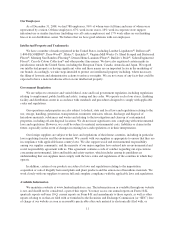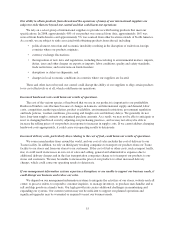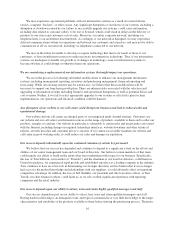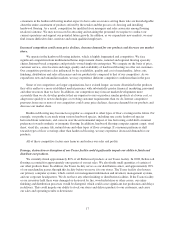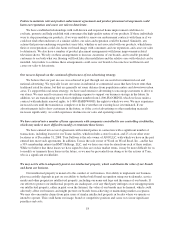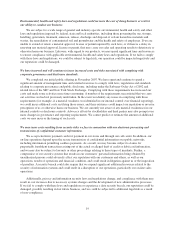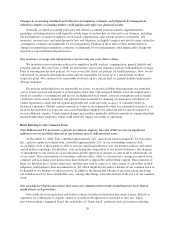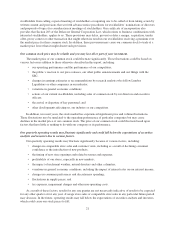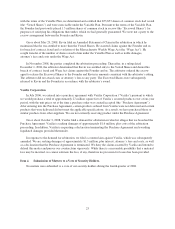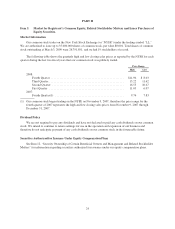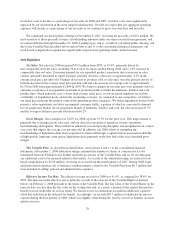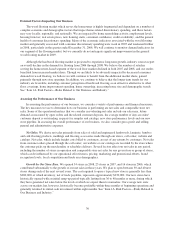Lumber Liquidators 2008 Annual Report Download - page 26
Download and view the complete annual report
Please find page 26 of the 2008 Lumber Liquidators annual report below. You can navigate through the pages in the report by either clicking on the pages listed below, or by using the keyword search tool below to find specific information within the annual report.Changes in accounting standards and subjective assumptions, estimates and judgments by management
related to complex accounting matters could significantly affect our financial results.
Generally accepted accounting principles and related accounting pronouncements, implementation
guidelines and interpretations with regard to a wide range of matters that are relevant to our business, including
but not limited to, revenue recognition, stock-based compensation, sales returns reserves, inventories, self-
insurance, income taxes, unclaimed property laws and litigation, are highly complex and involve many subjective
assumptions, estimates and judgments by our management. Changes in these rules or their interpretation or
changes in underlying assumptions, estimates or judgments by our management could significantly change our
reported or expected financial performance.
Our insurance coverage and self-insurance reserves may not cover future claims.
We maintain various insurance policies for employee health, workers’ compensation, general liability and
property damage. Effective June 1, 2008, we entered into certain new insurance policies with modified coverage.
Prior to entering into the new policies, we were covered by fixed cost policies for health insurance. Now, we are
self-insured on certain health insurance plans and are responsible for losses up to a certain limit for these
respective plans. We continue to be responsible for losses up to a certain limit for general liability and property
damage insurance.
For policies under which we are responsible for losses, we record a liability that represents our estimated
cost of claims incurred and unpaid as of the balance sheet date. Our estimated liability is not discounted and is
based on a number of assumptions and factors, including historical trends, actuarial assumptions and economic
conditions, and is closely monitored and adjusted when warranted by changing circumstances. Our history of
claims experience is short and our significant growth rate could affect the accuracy of estimates based on
historical experience. Should a greater amount of claims occur compared to what was estimated or medical costs
increase beyond what was expected, our accrued liabilities might not be sufficient and we may be required to
record additional expense. Unanticipated changes may produce materially different amounts of expense than that
reported under these programs, which could adversely impact our results of operations.
Risks Relating to Our Common Stock
Tom Sullivan and TA Associates, a private investment company, have the ability to exercise significant
influence over us and their interests in our business may be different than yours.
At December 31, 2008, Tom controlled approximately 34%, and certain funds managed by TA Associates,
Inc., a private equity investment firm, controlled approximately 12%, of our outstanding common stock.
Accordingly, each of these parties is able to exercise significant influence over our business policies and affairs
and all matters requiring a stockholders’ vote, including the composition of our board of directors, the adoption
of amendments to our certificate of incorporation and the approval of mergers or sales of all or substantially all
of our assets. This concentration of ownership could also delay, defer or even prevent a change in control of our
company and may make some transactions more difficult or impossible without their support. These interests of
these stockholders may conflict with yours, and they may seek to cause us to take courses of action that, in their
judgment, could enhance their investment in us, but which might involve risks to holders of our common stock or
be harmful to our business or other investors. In addition, the timing and volume of any transactions involving
our common stock by these stockholders may, among other things, cause fluctuations in the price of our common
stock.
Our anti-takeover defense provisions may cause our common stock to trade at market prices lower than it
might absent such provisions.
Our certificate of incorporation and bylaws contain several provisions that may make it more difficult or
expensive for a third party to acquire control of us without the approval of our board of directors. These
provisions include a staggered board, the availability of “blank check” preferred stock, provisions restricting
20



